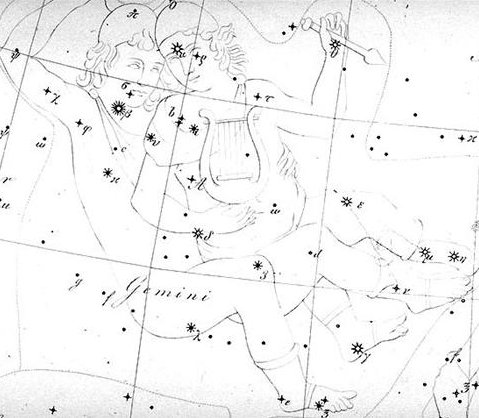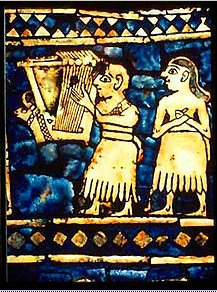|
5. The strings of the Gemini instrument are not necessarily 6 in number and its shape varies according to what the drawer had in mind:
In this example (by Friedrich Argelander, Neue Uranometrie, 1843, according to Linda Hall's site) its cup outline may have been drawn to show an inverted capital omega letter (Ω). It could illustrate how no longer the 'cloth of darkness' covers earth, how no longer 'life' (light) is waiting to be hatched inside 'the egg' - cfr the myth of how Tagaroa was born (in The Rain God): ... Long ago in the very beginning of time there dwelt within a shell an infant god whose name was Ta'aroa. He was Ta'aroa the unique one, the ancestor of all gods, the creator of the universe whose natures were myriad, whose backbone was the ridgepole of the world, whose ribs were its supporters. The shell was called Rumia, Upset. Becoming aware at last of his own existence and oppressed by a yearning loneliness Ta'aroa broke open his shell and, looking out, beheld the black limitless expanse of empty space. Hopefully, he shouted, but no voice answered him. He was alone in the vast cosmos ... There are no bright stars marking this lyre, but the faint star omega (ω) is rising a little earlier as if to indicate an open egg-shell. It is close to Castor's navel (a word similar to the Hebrew nevel). And the word nabla is similar to German Nebel (= mist). In the nebulous early morning dew covered the ground and mists were hovering everywhere. The ancient Sumerian lyre had a form not much different from the Egyptian nabla:
"A lyrist on the Standard of Ur, believed to date to between 2600–2400 BCE." (Wikipedia) Let's therefore put also ω Gemini in our list:
It is located very close to the beginning of the 8th hour. We can imagine the preceding day (Ga2-10, where 2 * 10 = 20) illustrates how an opening is created to release a new 'year':
|
||||||||||||||||||||||||||||||||||||||||||||||||||||||||||||||||||||||||||||||||||||||||||||||||||||||||||||||||||||||||||||||||||||||||||||||||||||||||||||||||||||||||||











